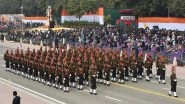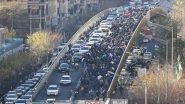New Delhi, April 26: Ministry of Labour and Employment on Tuesday said that making an inference that half of the working-age population has lost hope for work is "factually incorrect", adding that the labour force and workforce in the country increased during 2017-18 to 2019-20.
Further, the Ministry said that there has been an increase in the female labour force, as well as female worker population ratio, during the year 2017-18 to 2019-20 is higher compared to an increase in the male labour force and worker population ratio. Government Hopeful of Bouncing Back in Employment Market With Various Govt Schemes.
This comes a day after media reports claimed that millions of discouraged Indians, especially women, have stopped looking for jobs over slim opportunities in the past five years and are quitting the labour force entirely.
Employment is the primary concern of the Government of India and various steps are being taken by Ministries/Departments for the generation of employment opportunities in the country.
The Ministry further said that the Labour Force Participation Rate (LFPR) is the percentage of the population which is either working (employed) or seeking work (unemployed).
"It is important to note that the complete working-age population may not be working or seeking work. A substantial portion of the working-age population is either pursuing education (secondary/ higher/ technical education) or engaged in unpaid activities like the production of goods for own consumption, unpaid domestic activities or caregiving services for household members, volunteering, training, etc," the release stated.
"Thus, making inference by some section of media that half of the working-age population has lost hope for work is factually incorrect," it added. As per the reports of the Ministry of Education for year 2019-20, more than 10 crore person were enrolled in Secondary, Higher Secondary, Higher or Technical education during 2019-20 out of which, about 49 per cent were female.
"Majority of these students pursuing higher education are in the working-age population but, all of them may not be seeking work. Similarly, not all females engaged in unpaid domestic services for household members may be seeking paid work," Ministry's release read.
Further, it stated that the authentic data source of employment/unemployment indicators in India is released by the Ministry of Statistics and Programme Implementation (MoSPI) through the Periodic Labour Force Survey (PLFS) which is conducted in 2017-18.
"The PLFS data indicates that the labour force and workforce in the country have increased steadily during 2017-18 to 2019-20 and on the other hand Unemployment Rate has declined.It is further evident from the above data that the increase in the female labour force, as well as the female worker population ratio during years 2017-18 to 2019-20, is higher compared to the increase in male labour force and worker population ratio," the release stated.
The Economic Survey 2021-22, as per the release, estimates indicate there was an increase of 4.75 crores in employment during 2019-20 compared to 2018-19. The increase in the labour force during 2019-20 compared to the previous year was 4.52 crore. Thus, during 2019-20, more employment was generated than the increase in the labour force in the country.
(The above story is verified and authored by ANI staff, ANI is South Asia's leading multimedia news agency with over 100 bureaus in India, South Asia and across the globe. ANI brings the latest news on Politics and Current Affairs in India & around the World, Sports, Health, Fitness, Entertainment, & News. The views appearing in the above post do not reflect the opinions of LatestLY)













 Quickly
Quickly


